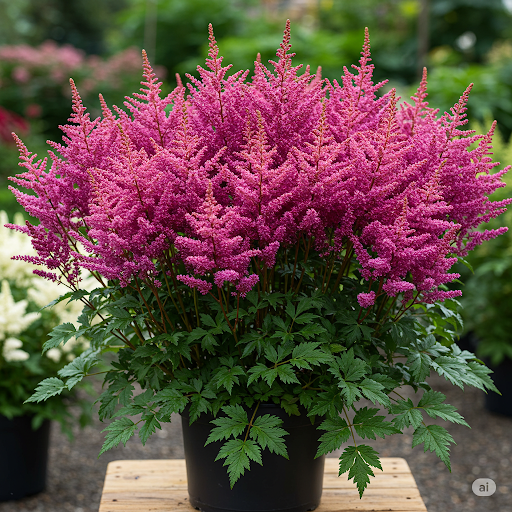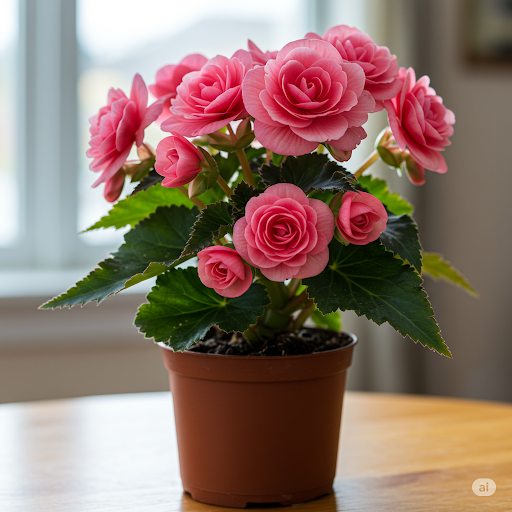Promoting Blooms & Post-Flowering Care for Potted Astilbe
Astilbe is highly prized for its spectacular, feathery plumes that add bursts of color and texture to summer gardens. When growing these lovely perennials in containers, maximizing their bloom potential and knowing how to care for them once the show is over are key to long-term success.
This article will guide you on how to encourage abundant flowering on your potted Astilbe and what steps to take for post-flowering management.
How to Promote Abundant Flowering on Potted Astilbe
Getting your potted Astilbe to produce a spectacular display of blooms primarily comes down to meeting its basic cultural needs consistently throughout the growing season leading up to flowering.
- Provide the Right Light Conditions: While Astilbe are shade lovers, too much dense shade can result in fewer flowers. They perform best in part shade, ideally receiving cooler morning sun followed by protection from the intense afternoon sun. Aim for a spot that gets 3-4 hours of morning sun or dappled light throughout the day. (Avoid full sun!).
- Ensure Consistent Moisture: This is perhaps the most critical factor for Astilbe health and flowering. These plants hate drying out. Any period of drought stress, especially as flower buds are forming or developing, can severely reduce the number and size of blooms, or even cause buds to shrivel. Maintain consistently moist (but not soggy) soil by watering regularly, checking the soil moisture frequently, especially during warm or windy weather.
- Fertilize Appropriately: As discussed in a previous article, potted plants have limited nutrients. Feeding your Astilbe helps provide the energy needed for flowering. Use a balanced, all-purpose fertilizer (like 10-10-10) or one slightly higher in phosphorus (the middle number, which supports blooms) in the spring as new growth emerges and maybe once more before flowering begins. Avoid high-nitrogen fertilizers during or right before the bloom period, as this encourages leafy growth over flowers.
- Use the Right Soil & Pot: Start with a high-quality, moisture-retentive yet well-draining potting mix and a pot size that allows room for root growth. Healthy roots are fundamental to supporting energy-intensive flowering.
- Allow Maturity: Like many perennials, a young Astilbe might not flower profusely in its first year in a pot. Give it time to establish a strong root system. Flowering generally improves in subsequent years.
Meeting these basic needs – the right light, consistent water, and adequate nutrients – provides the foundation for your potted Astilbe to produce its best possible flower display.
Post-Flowering Care & Management
Once your Astilbe's beautiful plumes have faded, your care shifts from encouraging blooms to maintaining plant health and preparing it for the next season.
- Deadheading (Removing Spent Blooms): This is largely a matter of personal preference with Astilbe.
- To Deadhead: Cut the spent flower stalks back to the base of the plant. This tidies up the plant's appearance and prevents the plant from putting energy into producing seeds.
- To Leave Blooms: Many gardeners choose to leave the faded flower plumes on the plant. They often retain attractive color (turning shades of brown or tan) and texture, providing visual interest in the container garden through late summer, fall, and even into winter, especially when dusted with snow.
- Note: Deadheading Astilbe does not typically encourage a second flush of blooms in the way it does for some other perennials.
- Continue Watering: Astilbe still needs consistent moisture even after flowering is finished. Healthy foliage through the rest of the growing season is crucial as the leaves photosynthesize and store energy in the roots for next year's flowers. Don't let the pot dry out.
- Stop Fertilizing: By late summer or early fall, stop fertilizing your potted Astilbe. This signals the plant to slow down growth and begin preparing for dormancy rather than pushing tender new growth that could be damaged by frost.
- Maintain Foliage: Keep the foliage healthy until it naturally dies back in the fall. Remove any yellowing or damaged leaves as needed.
- Prepare for Winter: As temperatures drop, protect your potted Astilbe roots from freezing and thawing cycles, which can damage them. You can group pots together, mulch the top of the soil, move the pot to a protected location like an unheated garage or porch, or wrap the pot with insulating material.
- Consider Division: If your Astilbe has been in the same pot for several years and you notice a decline in flowering or the center looks crowded, it may be time to divide the plant in the spring before new growth gets too far along. Division rejuvenates the plant and promotes better flowering in the future.
Conclusion
Getting beautiful blooms from your potted Astilbe involves providing consistent care centered on their needs for light, moisture, and nutrients during the growing season. Once the flowers fade, you can choose to deadhead for tidiness or leave the plumes for winter interest, but continue watering and stop fertilizing to prepare the plant for healthy dormancy and vigorous growth – and blooms – next spring.


Comments
Post a Comment